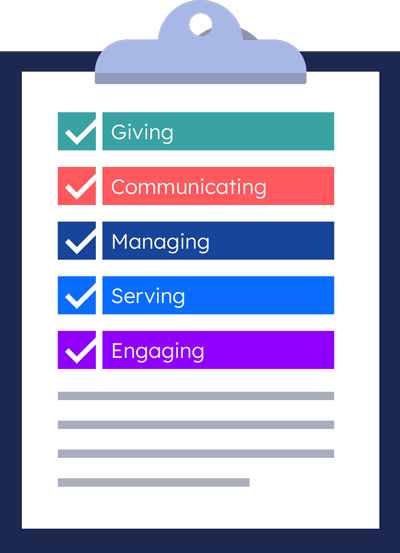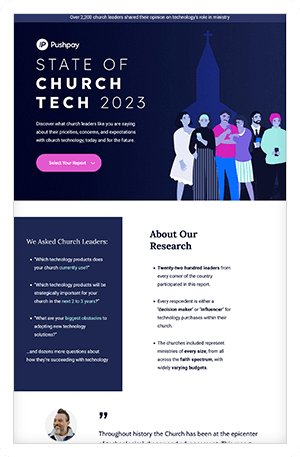4. Write your sermon
With a solid outline in place and a deep well of insights from your study, the actual writing is fairly straightforward. There are no rules about how you have to start, so if you’re having trouble coming up with a good introduction, skip it. Some people prefer to start with the conclusion, or just dive right into the main points. That’s fine! For the sake of this guide though, we’re going to start at the beginning.
But first, a big tip.
WRITE HOW YOU TALK
Obviously, a sermon isn’t just words people read silently on a page. You’re not writing an essay. These are things you’re going to say out loud. But a lot of times when you sit down to write—especially after you’ve been reading all those academic works, which are usually written for scholarly audiences—it’s easy to write your sermon as though it’s a scholarly paper.
The way you talk should affect the rhythm of your writing, the words you choose, and the way you work from one idea to the next. You could read your sermon out loud as you go, but the main thing is to make sure it sounds the way you would like to talk to your congregation.
INTRODUCTION
There are two main goals for your introduction:
- Hook your audience
- Get them oriented
You want to catch your listeners’ attention from the very beginning. But a good sermon may also start with a little housekeeping. In a large church, it may be important to introduce yourself and your role—especially if you’re not the usual preacher, if you have an online audience, or if there are a lot of visitors in the room. You might also want to acknowledge things that are different, or—if you’re not the teaching pastor—touch on why you’re the one preaching this weekend. Is someone on sabbatical? Visiting another campus? Attending a conference?
Some pastors simply prefer to hit the ground running and jump into an engaging story or introduce the passage they’re preaching on. That’s fine if people are used to hearing from you, but this is also a valuable time to set expectations for your congregation. You don’t want them to spend the first several minutes thinking, “Where is this going?” or “What’s the point of this?”
Relevant stories from your own life, your congregation, the Bible, hypothetical situations, the news, or things you’ve been reading can all make great hooks. So can intriguing questions or surprising, declarative statements. But you should move quickly from your hook to your big idea.
Orient your audience by giving them a glimpse of where you’re going and what you’re going to show them. You might spend some time talking about misconceptions about your topic, questions people ask, or what makes your topic important to the life of a Christ follower.
For an expository sermon, you’ll probably want to start by providing some context about the key people, any important events and conversations that happened before the passage you’re looking at, or how it fits into the Bible’s overarching narrative.
Give people all the information they need to keep up as you get into your points.
FLESH OUT YOUR MAIN POINTS
Hopefully your outline identified all the key points you want to make. This is where you’ll take the time to find the most compelling way to phrase each big idea. You may want to use alliteration or make them rhyme so that they’re easier for people to remember, but you certainly don’t have to. It’s often better to focus on being clear than being clever.
Each main point should probably be a sermon slide and/or fill-in-the-blank, so that as you expand on it, your congregation can still keep the big idea in mind and chew on it.
Before you get too far into your own thoughts on each point, be sure to add any notes and quotes that came up in your studies (if you didn’t put them in during the outlining phase). If you think they cover all the subpoints you want to get into, then your focus here will be on connecting them to your main point and providing the context people need to understand them.
Are there things your congregation needs to be familiar with before a quote or insight makes sense to them? Set it up and walk them through it.
Remember, you’re working with a word limit here. It will be really helpful if you estimate how many words you think you’ll spend on each section. If you read relatively slowly, you should expect every 100 words or so to represent roughly one minute of preaching. If you’re a fast talker though, it could be more like 150 words per minute of preaching.
Each point doesn’t have to be the same length—it’s fine to spend more time on the things that matter more—but if one big idea takes up most of your sermon, maybe your topic was too broad, and that’s what your sermon should be on. Or you might need to break it into multiple points.
MAKE CLEAR TRANSITIONS
In writing, it’s easy to jump right from one point to the next with little or no transition. But when your audience is listening to you, those rough transitions become a lot more jarring. As you finish each point, be sure you take the time to reorient your congregation before you make your next point. If one big idea flows naturally into the next, the connection will be clear and simple. But if your big ideas are really only connected by your topic, you may have to zoom out again and revisit the premise of your sermon before leading into your next key point.
WRAP IT UP
There are lots of ways to write a good ending. You can tie all your points together under the umbrella of your main idea. Or you could use your earlier points as scaffolding for one final idea that builds on everything you’ve talked about so far. You might revisit your introduction—maybe even bring back your hook.
The important thing is to know when to “land the plane.”
Your congregation can often sense when you’re nearing the end of your sermon—or when you should be. They can see the landing strip, and so can you. This is not the time to cram in everything you didn’t have time to get into and circle the landing strip. It’s time to get the landing gear in place, descend, and touch down smoothly.
Find a succinct way to get your main idea across, and land the plane.
DON’T FORGET TO CITE YOUR SOURCES
It’s easy to overlook this part, but it’s extremely important. Over the course of your studies, you’ve read a lot of similar ideas and pulled from a lot of sources. It’s easy to lose track of what came from where or even what ideas you actually came up with yourself!
And that’s why a lot of preachers accidentally commit plagiarism. It’s good practice to always give credit to any person you quoted from or who came up with a unique line of thinking you built on. Not only does this help your congregation find good resources and expertise, but it also prevents them from assuming an idea or quote was yours, and more importantly, it’s not stealing.
This might seem nitpicky, but if you plan on publishing your sermon online in any format, you should be especially cautious about even accidentally committing plagiarism. If someone discovers that you’ve plagiarized their writing or ideas and post it online, the very least that will happen is that the platform will likely pull your sermon from their archives, so you’ll have to find another way to share it online. The worst case scenario? You could lose your job.
5. Revise your sermon
Once you’ve written your sermon, it’s still not done. Revision is a vital part of the writing process, and it ensures that you produce your best work. The more time you have for this stage, the better. But you can always shape your revision process to fit your timeline.
SET IT ASIDE
When you finish writing, the first thing you should do is set it aside. Don’t look at it anymore. Close the document. Put it away. You’ve poured a lot of time and energy into this, and if you try and edit it right now, after you’ve just finished putting your ideas into words, you’re going to miss a lot of really obvious mistakes.
Ideally, you want to get away from your sermon for enough time that you can look at it with fresh eyes. This could take days, weeks, or even a month or more before you stop dreaming about it, thinking about it while you’re doing other ministry tasks and things around the house. You can speed up the process by getting invested in something else, like a good book, an unrelated article, an activity with your family, or even a movie or a show.
You want to get to the point where when you look at your sermon again, it feels like someone else wrote it. That’s when you can be truly, brutally honest with yourself and cut that sentence you thought was so clever before, or you can see that one of your big ideas is really clunky and unclear. You might also discover something brilliant that you glazed over during the writing, and by cutting away some of the fluff, you can make new sections really shine.
LISTEN TO YOUR SERMON OUT LOUD
When you read your writing out loud, it almost always sounds different than what you imagined in your head. You might notice mistakes, but the main thing you’re listening for is the rhythm. How does it sound? How does each sentence flow into the next? If you feel good about your sermon, record yourself, and play it back. And if you’re still convinced that it sounds good, it’s time to practice in front of someone else.
PRACTICE IN FRONT OF SOMEONE ELSE
In an ideal world, you’d practice your sermon in front of someone who has more preaching experience than you.
But that’s not always possible, and a lot of church leaders don’t have mentors or even peers they can turn to. That’s OK. If your church has elders or other staff you feel comfortable being vulnerable with, invite them into the process. Think of your sermon as a message God has given to you, but which the leaders of your church can refine together to share with your congregation.
The goal here is to get an outside perspective—thoughts that don’t come from your own head. A spouse, family member, or good friend always works, too.
Find the process that works best for you
Ultimately you should write a sermon in whatever way produces your best work. Maybe you write better without an outline. Or you prefer to outline before you study. Or maybe another preacher has some techniques you can add to your process. Great!
The important thing is to intentionally, prayerfully approach your sermon so that you can avoid developing bad habits and give this responsibility the attention it deserves.
Extend the Life of Your Sermon
Extend the life of your sermon by making it available anytime, anywhere. With a church app, your congregation can access your services right from their phones. A streamlined media experience makes it easy for your congregation to stay connected and engaged with your church throughout the week. They can listen to sermons, music, and podcasts with the audio player or watch videos. They’ll also have the ability to save a sermon and listen to it later.
As you add new content to your church app, there’s also a way to send push notifications to app users, so your people always know what’s available.
Click here to learn more about the Pushpay Church App.








